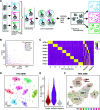Cell Hashing with barcoded antibodies enables multiplexing and doublet detection for single cell genomics
- PMID: 30567574
- PMCID: PMC6300015
- DOI: 10.1186/s13059-018-1603-1
Cell Hashing with barcoded antibodies enables multiplexing and doublet detection for single cell genomics
Abstract
Despite rapid developments in single cell sequencing, sample-specific batch effects, detection of cell multiplets, and experimental costs remain outstanding challenges. Here, we introduce Cell Hashing, where oligo-tagged antibodies against ubiquitously expressed surface proteins uniquely label cells from distinct samples, which can be subsequently pooled. By sequencing these tags alongside the cellular transcriptome, we can assign each cell to its original sample, robustly identify cross-sample multiplets, and "super-load" commercial droplet-based systems for significant cost reduction. We validate our approach using a complementary genetic approach and demonstrate how hashing can generalize the benefits of single cell multiplexing to diverse samples and experimental designs.
Conflict of interest statement
Ethics approval and consent to participate
Not applicable for this study.
Competing interests
MS, PS and BHL have filed a patent application based on this work (US provisional patent application 62/515-180). BZY is an employee at BioLegend Inc., which is the exclusive licensee of the New York Genome Center patent application related to this work. All other authors declare that they have no competing interests.
Publisher’s Note
Springer Nature remains neutral with regard to jurisdictional claims in published maps and institutional affiliations.
Figures



Similar articles
-
Nuclei multiplexing with barcoded antibodies for single-nucleus genomics.Nat Commun. 2019 Jul 2;10(1):2907. doi: 10.1038/s41467-019-10756-2. Nat Commun. 2019. PMID: 31266958 Free PMC article.
-
Comparative analysis of antibody- and lipid-based multiplexing methods for single-cell RNA-seq.Genome Biol. 2022 Feb 16;23(1):55. doi: 10.1186/s13059-022-02628-8. Genome Biol. 2022. PMID: 35172874 Free PMC article.
-
Sample-multiplexing approaches for single-cell sequencing.Cell Mol Life Sci. 2022 Aug 5;79(8):466. doi: 10.1007/s00018-022-04482-0. Cell Mol Life Sci. 2022. PMID: 35927335 Free PMC article. Review.
-
SCITO-seq: single-cell combinatorial indexed cytometry sequencing.Nat Methods. 2021 Aug;18(8):903-911. doi: 10.1038/s41592-021-01222-3. Epub 2021 Aug 5. Nat Methods. 2021. PMID: 34354295 Free PMC article.
-
Turning single cells into microarrays by super-resolution barcoding.Brief Funct Genomics. 2013 Mar;12(2):75-80. doi: 10.1093/bfgp/els054. Epub 2012 Nov 22. Brief Funct Genomics. 2013. PMID: 23178478 Free PMC article. Review.
Cited by
-
A microfluidic Braille valve platform for on-demand production, combinatorial screening and sorting of chemically distinct droplets.Nat Protoc. 2022 Dec;17(12):2920-2965. doi: 10.1038/s41596-022-00740-4. Epub 2022 Oct 19. Nat Protoc. 2022. PMID: 36261631 Review.
-
Technology meets TILs: Deciphering T cell function in the -omics era.Cancer Cell. 2023 Jan 9;41(1):41-57. doi: 10.1016/j.ccell.2022.09.011. Epub 2022 Oct 6. Cancer Cell. 2023. PMID: 36206755 Free PMC article. Review.
-
Inference of B cell clonal families using heavy/light chain pairing information.PLoS Comput Biol. 2022 Nov 28;18(11):e1010723. doi: 10.1371/journal.pcbi.1010723. eCollection 2022 Nov. PLoS Comput Biol. 2022. PMID: 36441808 Free PMC article.
-
Human RP105 monoclonal antibody enhances antigen-specific antibody production in unique culture conditions.iScience. 2024 Aug 3;27(9):110649. doi: 10.1016/j.isci.2024.110649. eCollection 2024 Sep 20. iScience. 2024. PMID: 39246445 Free PMC article.
-
Single-cell RNA sequencing for engineering and studying human islets.Curr Opin Biomed Eng. 2020 Dec;16:27-33. doi: 10.1016/j.cobme.2020.06.003. Epub 2020 Jul 4. Curr Opin Biomed Eng. 2020. PMID: 33738370 Free PMC article.
References
Publication types
MeSH terms
Substances
Grants and funding
LinkOut - more resources
Full Text Sources
Other Literature Sources
Molecular Biology Databases

